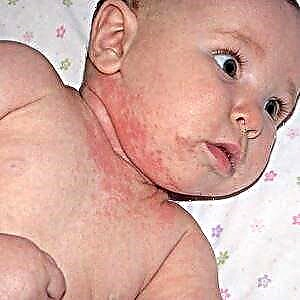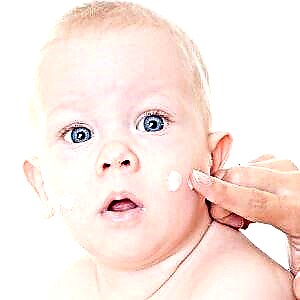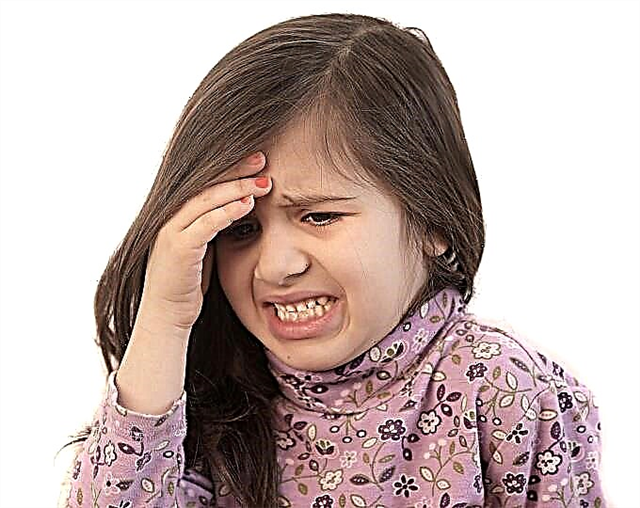Many mothers, having seen rashes on the body of a newborn baby, wonder - is it an allergy or just a sweat? Indeed, the tactics of further actions fundamentally depends on a correctly established preliminary diagnosis. In any case, a baby with rashes should be shown to a specialist. But if there is no such possibility, what should mom do?
In this article we will talk about how to distinguish prickly heat from allergies in a child.
Prickly heat in children
Prickly heat (miliary) develops in children in conditions of high humidity and ambient temperature due to insufficient thermoregulation system and the work of the sebaceous glands.
Factors predisposing to the appearance of prickly heat in newborns:
 imperfection of thermoregulation;
imperfection of thermoregulation;- thinness and vulnerability of the epidermis;
- reduced immune protection of the baby's skin;
- well-developed network of blood vessels of the skin;
- narrowed ducts of the sebaceous glands;
- the female gender of the child;
- non-observance of hygienic rules for caring for babies;
- excessive wrapping of children.
There are 3 forms of miliary:
- crystalline;
- red;
- deep.
A rash with prickly heat is represented by bubbles or nodules (with a red form), the color is pale pink. More often appears in places of increased overheating of the skin under clothes, in folds. The rashes do not flake off, do not itch. Miliaria passes quickly even without the use of medicinal ointments, subject to hygiene rules.
How to distinguish prickly heat from allergies in babies?
The following recommendations will help to correctly diagnose prickly heat or allergies in a newborn.
So, you have found rashes on the baby's body.
 Examine the child completely for the presence of rashes, their location and nature.
Examine the child completely for the presence of rashes, their location and nature.- Try to remember if there were predisposing factors for the appearance of prickly heat in an infant: overheating, high humidity, excessively warm clothes.
- Risk factors for the appearance of allergic rashes include the recent introduction of new products, the use of a different washing powder, new skin care products, and the use of medications.
In the direction of the allergic nature of the rash indicate:
- bright, widespread rashes on any part of the body;
- characteristic morphological elements of the rash: blisters, papules, vesicles;
- peeling;
- weeping;
- intense itching;
- recent introduction of new complementary foods;
- the use of new cosmetic products for care;
- taking medications, especially antibiotics.
In favor of prickly heat the following factors indicate:
- no rash on the face;
- a rash in the form of pale pink blisters;
- elements of the rash are located on areas of the skin covered with clothing;
- the day before, the child could overheat, was too warmly dressed;
- lack of itching, peeling, skin wetness, crusts.
Skin care tips for babies prone to prickly heat and allergic rashes
If your children often suffer from rashes, these recommendations will help to avoid exacerbations.
1. Bathe your child daily.
Remember that a warm bath is better than a shower. The water temperature should be kept within 37 ° C.
Do not use rough washcloths to avoid injury to your skin.
Bathing water is recommended to be defended or boiled. Mild detergents of the Mustella, Topikrem, Atoderm lines can be added to it.
After the bath, pat the baby's skin dry with a towel, do not wipe it off.

2. The baby's skin should be moisturized on the advice of a doctor. It is often necessary up to 4 - 6 applications per day. Means "Lipikar", "Mustella StelAtopia", "Realba", "Atoderm" have proven themselves well.
3. Baby's clothes should be cotton, do not use synthetic fabrics.
- the baby's skin must breathe;
- it is forbidden to wrap up the child.
4. If you notice that the baby is sweating, then change his clothes.
5. Do not use detergents containing ammonia to clean the apartment. It is better to use special products for people with allergies.
6. Maintain the required level of humidity and temperature.
- use a humidifier;
- the recommended air temperature in the apartment is 20 - 22 ° С;
- carry out daily wet cleaning;
- use air purifiers.
In case of exacerbation of the child's disease, be sure to show the doctor. Remember that allergenic load worsens the course of the disease, so try to follow the doctor's recommendations on nutrition and hypoallergenic life.
Useful tips for caring for the skin of children with allergic dermatoses
 remember that creams are water-based, which means they dry out over time;
remember that creams are water-based, which means they dry out over time;- ointments moisturize the skin better;
- if the skin gets wet, lotions are used for treatment, if it peels off - fatty ointments;
- soap dries out the skin. Try to use special skin care products of the lines "Realba", "Lipikar", "Physiogel", "Atoderm";
- a bath with oil additives helps to relieve itching and dryness of the skin;
- to calculate the amount of cream required to apply to the area of the rash, you should remember the rule: the amount of cream corresponding to the phalanx of the finger is enough to apply to an area of skin the size of a palm.
Let's sum up
Brief information on the article, which will help parents to properly help the baby when rashes appear.
- A baby with a rash should be shown to a specialist.
- Prickly heat (miliary) develops in children in conditions of high humidity and ambient temperature due to insufficient thermoregulation system and the work of the sebaceous glands.
- The rash with prickly heat is represented by bubbles or nodules (with a red form), the color is pale pink.
- Risk factors for the appearance of allergic rashes include the recent introduction of new products, the use of a different washing powder, new care cosmetics, and the use of medications.
- The baby's skin should be moisturized on the advice of a doctor. It is often necessary up to 4 - 6 applications per day.
- If the skin gets wet, lotions are used for treatment, if it peels off - fatty ointments.
Thus, in this article we examined the main prerequisites for the appearance of prickly heat in a child, the features of the elements of the rash in miliary and allergic dermatoses. Also, the issues on proper skin care for the existing tendency to rashes were highlighted.

 imperfection of thermoregulation;
imperfection of thermoregulation; Examine the child completely for the presence of rashes, their location and nature.
Examine the child completely for the presence of rashes, their location and nature. remember that creams are water-based, which means they dry out over time;
remember that creams are water-based, which means they dry out over time;

